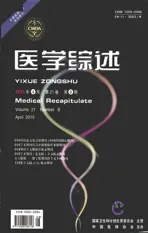依折麦布及其联合治疗的研究进展
2015-02-10余逸超综述龙明智审校
余逸超,张 健(综述),龙明智(审校)
(1.南京医科大学第二附属医院心脏科,南京 210011; 2.南京医科大学第一附属医院心脏科,南京 210029)
依折麦布及其联合治疗的研究进展
余逸超1△,张健2(综述),龙明智1※(审校)
(1.南京医科大学第二附属医院心脏科,南京 210011; 2.南京医科大学第一附属医院心脏科,南京 210029)
摘要:依折麦布作为小肠胆固醇吸收抑制剂,在降低总胆固醇、低密度脂蛋白胆固醇、三酰甘油及载脂蛋白B的同时,可提升高密度脂蛋白胆固醇水平;此外,依折麦布尚有抗炎、抗动脉粥样硬化等作用,可进一步降低心血管事件风险;且依折麦布在具有较高安全性的同时,不升高血清前蛋白转化酶枯草溶菌素9的水平,故而不影响血清低密度脂蛋白胆固醇的代谢。该文就依折麦布的作用机制、单用及与他汀联合用药的研究进展予以综述。
关键词:依折麦布;药理学机制;药理作用;安全性
国家胆固醇教育计划成人治疗小组Ⅲ方针已推荐将有高风险因素的心血管患者的低密度脂蛋白胆固醇(low density lipoprotein cholesterol,LDL-C)降至1.82 mmol/L以下[1]。然而有试验表明,在单用他汀治疗的患者中,仅有2/3的患者有心血管高危因素,其LDL-C可降至2.6 mmol/L 以下,并且仅不到1/3 的患者LDL-C可降至目标值1.82 mmol/L以下[2]。有荟萃分析显示,诸如贝特类、烟酸类、依折麦布等非他汀治疗,也可在降低LDL-C的同时,减少冠状动脉粥样硬化性心脏病(冠心病)的风险[3]。这些结果显示,在他汀治疗基础上联用其他降脂药可更进一步降低LDL-C水平。而他汀类与贝特类、他汀类与烟酸类联用均未得到广泛应用,是因为潜在的肌病、肝毒性风险或患者的低耐受性。依折麦布因其特殊代谢途径而具有较高的安全性和耐受性,成为当前与他汀类联合治疗策略的理想选择。现就依折麦布及其联合治疗的研究进展予以综述。
1药理学机制
1.1依折麦布的作用途径依折麦布对胆固醇吸收的选择性抑制靶点为空肠刷状缘Ni-emann-Pick C1样蛋白(NPC1L1)[4]。药物代谢实验几乎未发现依折麦布经细胞色素P450途径代谢,故极少干预其他药物代谢[5]。
1.2依折麦布与他汀联合治疗的优势他汀类药物可显著降低LDL-C水平,通过剂量依赖方式最高使其下降60%[6]。然而,他汀类药物阻止肝胆固醇合成的同时,亦可代偿性增加肝LDL-C受体水平,增加血浆LDL-C吸收入肝,增加肠道对胆固醇的吸收。在动物模型中,依折麦布单一治疗组3-羟基-3-甲基戊二酰辅酶A还原酶表达呈代偿性增加趋势[7]。因此,依折麦布与他汀联合治疗高脂血症将起到协同调脂作用[8]。
2依折麦布的药理作用
2.1依折麦布与肠道内胆固醇的吸收依折麦布可通过抑制NPC1L1蛋白来减少胆固醇的吸收,NPC1L1蛋白能促进肠胆固醇的吸收,它的缺乏可导致胆固醇吸收减少约70%[9]。Stitziel等[10]根据基因测序,发现了15种使NPC1L1蛋白功能缺失的基因突变,这些基因突变携带者血清中LDL-C的水平明显低于非基因突变携带者血清中的LDL-C水平。目前认为,NPC1L1蛋白是依折麦布的主要作用靶点,高密度脂蛋白受体与CD36可能是依折麦布的潜在作用位点[11]。依折麦布在胰岛素抵抗的个体中,其减少胆固醇吸收的效果还不是特别清楚。然而,研究显示,对一种有代谢综合征和胰岛素抵抗的大鼠(JCR:LA大鼠)用依折麦布治疗8周,无论是单用还是和他汀类联用,与未经治疗的JCR:LA大鼠相比,胆固醇吸收明显减少[12]。
2.2依折麦布与胆固醇的积累Mangat等[12]用荧光动脉灌注研究发现,JCR:LA-cp大鼠与体型较瘦的无胰岛素抵抗大鼠相比,动脉壁更易形成脂蛋白(伴随大量胆固醇)的积聚;且依折麦布治疗组的JCR:LA-cp大鼠,相比未经依折麦布治疗组,颈动脉内脂蛋白(伴随大量胆固醇)有明显减少,而且与单用依折麦布组相比,依折麦布联合他汀类治疗组对抗动脉壁胆固醇的沉积作用更强[13]。以上发现均证实,依折麦布能够减少动脉壁胆固醇的沉积,同时也表明依折麦布联合他汀类药物治疗可更有效降低动脉壁胆固醇水平。此外,VYCTOR 试验也有类似结果,依折麦布联合他汀类药物治疗,其颈动脉内膜厚度明显减少[14]。
2.3依折麦布与血小板聚集尽管过去很多试验表明依折麦布可减少血小板聚集[15],但最近Camargo等[16]发现,依折麦布联合辛伐他汀并没有在阿司匹林或氯吡格雷的基础上进一步减少血小板聚集;该试验将冠心病的对象随机分为4组接受1周的治疗并加以评估,组1:阿司匹林100 mg/d;组2:阿司匹林100 mg/d+辛伐他汀40 mg/d+依折麦布10 mg/d;组3:氯吡格雷75 mg/d(首剂量负荷300 mg)+辛伐他汀40 mg/d+依折麦布10 mg/d;组4:氯吡格雷75 mg/d;结果发现,总胆固醇、LDL-C、三酰甘油水平在组2及组3中均<组1及组4(P<0.05);在经过阿司匹林(花生四烯酸:组1<组3及组4,P=0.034)或氯吡格雷(腺苷:组3及组4<组1及组2,P<0.0001)治疗后,血小板聚集均减弱;而辛伐他汀40 mg/d 加依折麦布10 mg/d并没有改变血小板聚集情况。该研究推测,辛伐他汀加依折麦布的联合疗法减少心血管事件可能与其降脂及改善内皮功能有关。
2.4依折麦布与抗炎Tobaru等[17]选择了单用他汀治疗未达标的冠状动脉疾病患者,加用依折麦布10 mg治疗12周, 结果发现,加用依折麦布后,12周时水平与初始水平对比,总胆固醇[(4.5±0.9)mmol/L比(5.2±0.8) mmol/L,P<0.001],LDL-C[(0.14±0.8)mmol/L比(0.17±0.09) mmol/L,P<0.05],脂蛋白残粒胆固醇[(0.14±0.8) mmol/L比 (0.17±0.09) mmol/L,P<0.05]均呈显著下降;此外,LDL-C/高密度脂蛋白水平比值亦有明显下降[(0.05±0.02) mmol/L比(0.06±0.02) mmol/L,P<0.001];LDL-C达标患者的所占比重也明显增加(65.4%比0%,P<0.001),但是高敏C反应蛋白在治疗前后并未有明显变化;另一炎性标志物——肿瘤坏死因子表达水平在治疗后著显下降[(0.96±0.24) ng/L比(1.36±1.06) ng/L,P<0.05]。该研究提示,他汀联用依折麦布者LDL达标人数显著增加,肿瘤坏死因子表达水平显著下降。Moutzouri等[18]选择了153例高脂血症患者,随机分配到3个实验组,分别给予辛伐他汀40 mg/d、辛伐他汀10 mg/d 联合依折麦布10 mg/d、瑞舒伐他汀10 mg/d,治疗12周;并分别测定在治疗开始前和治疗12周后患者体内的8异构前列腺素F2α水平;结果治疗后与治疗前相比,3个实验组中8异构前列腺素F2α水平均显著下降(分别下降了10%、8%和6%,P<0.05),而下降程度在3个实验组中的差异无统计学意义。这一研究结果表明,依折麦布10 mg/d联合辛伐他汀10 mg/d,和辛伐他汀40 mg/d及瑞舒伐他汀10 mg/d一样,也可降低炎性标志物8异构前列腺素F2α的水平。此外,最近研究发现,给予非酒精性脂肪肝患者服用依折麦布10 mg/d,治疗6个月,结果显示,依折麦布可有效改善非酒精性脂肪肝患者的肝纤维化[19]。这一结果也鼓舞了更多学者进一步研究依折麦布的其他药理学作用。
3安全性
无论应用依折麦布单一治疗,或与他汀类调脂药物联合降脂治疗,均具有较高安全性[20-21]。当依折麦布单一治疗时,可能导致丙氨酸转氨酶或天冬氨酸转氨酶升高,升高的程度一般为转氨酶正常值上限的3倍以内,且与安慰剂对照组比较,这一影响差异并无统计学意义[20]。而且,依折麦布和他汀类联合降脂治疗所导致的肝酶升高,与他汀类单独降脂治疗时所致肝酶升高相比,其差异并无统计学意义[21]。Morrone等[22]荟萃分析了由14471个对象构成的18个他汀/依折麦布+他汀/安慰剂的随机对照试验,结果显示,肝酶升高的发生率在两组间差异无统计学意义。致命性肝衰竭,无论单用依折麦布或是依折麦布联合其他降脂药物治疗均罕见,仅有个别病例报道[23-25]。伴或不伴肌炎的肌痛以及肌酸激酶的升高在他汀治疗中相对常见[26]。然而在他汀治疗的基础上联合使用依折麦布,与单用他汀治疗相比,并不会增加肌酸激酶升高的发生率;一组含7个随机对照试验荟萃分析显示,单用依折麦布治疗或者是依折麦布联合他汀治疗,与安慰剂或是单用他汀疗法作对照,并不增加发生肌炎风险[27]。近来流行病学调查引发了大众对于低总血浆胆固醇水平可能增加肿瘤发生风险的担忧[28]。SEAS研究提示了他汀和依折麦布联合治疗导致低胆固醇血症,进而引发肿瘤的可能[29]。然而,更大规模关于依折麦布联合他汀治疗的试验——SHARP试验并不支持这一结论,该试验分析发现,他汀联合依折麦布与单用他汀比较,其肿瘤发生的差异并无统计学意义[30]。近年来发现,血清前蛋白转化酶枯草溶菌素9(proprotein convertase subtilisin/kexin type 9,PCSK9)可影响血清LDL的代谢从而使血清LDL升高,因此目前也有不少研究着力于那些广泛应用的降脂药对血清PCSK9的影响。2013年,Berthold等[31]在72例健康受试者身上进行了一项单中心、随机的开放试验,设立了辛伐他汀组、依折麦布组及辛伐他汀与依折麦布联用组,进行了为期14 d的试验;研究发现,他汀类显著增加了PCSK9 的水平,依折麦布则并没有增加PCSK9的水平,并且与他汀类治疗组相比,联合治疗组PCSK9升高的水平也没有显著增加。这一试验表明,依折麦布在降低血脂的同时,并未升高血清PCSK9的水平。
4小结
越来越多的证据表明,依折麦布与他汀类药物联用可有效延缓动脉粥样硬化进程,减少心血管不良事件的发生。此外,依折麦布尚有诸如抗炎、抗纤维化等其他作用,已被越来越多的临床试验证实。依折麦布与他汀联用增加肿瘤风险也已被大规模临床试验所否定,并且相比于他汀类,依折麦布在降脂的同时,并不增加血清PCSK9的水平。有关依折麦布的作用机制及临床循证证据,还有待于更大规模的临床试验验证。
参考文献
[1]Grundy SM,Cleeman JI,Merz CN,etal.Implications of recent clinical trials for the National Cholesterol Education Program Adult Treatment Panel III guidelines[J].Circulation,2004,110(2):227-239.
[2]Waters DD,Brotons C,Chiang CW,etal.Lipid treatment assessment project 2:a multinational survey to evaluate the proportion of patients achieving low-density lipoprotein cholesterol goals[J].Circulation,2009,120(1):28-34.
[3]Robinson JG,Wang S,Smith BJ,etal.Meta-analysis of the relationship between non-high-density lipoprotein cholesterol reduction and coronary heart disease risk[J].J Am Coll Cardiol,2009,53(4):316-322.
[4]Sugizaki T,Watanabe M,Horai Y,etal.The Niemann-Pick C1 like 1 (NPC1L1) inhibitor ezetimibe improves metabolic disease via decreased liver X receptor (LXR) activity in liver of obese male mice[J].Endocrinology,2014,155(8):2810-2819.
[5]Suchy D,Labuzek K,Stadnicki A,etal.Ezetimibe--a new approach in hypercholesterolemia management[J].Pharmacol Rep,2011,63(6):1335-1348.
[6]Law MR,Wald NJ,Rudnicka AR.Quantifying effect of statins on low density lipoprotein cholesterol,ischaemic heart disease,and stroke:systematic review and meta-analysis[J].BMJ,2003,326(7404):1423.
[7]Ness GC,Holland RC,Lopez D.Selective compensatory induction of hepatic HMG-CoA reductase in response to inhibition of cholesterol absorption[J].Exp Biol Med (Maywood),2006,231(5):559-565.
[8]Guyton JR.Combination regimens with statin,niacin,and intestinally active LDL-lowering drugs:alternatives to high-dose statin therapy?[J].Curr Opin Lipidol,2010,21(4):372-377.
[9]Altmann SW,Davis HR Jr,Zhu LJ,etal.Niemann-Pick C1 Like 1 protein is critical for intestinal cholesterol absorption[J].Science,2004,303(5661):1201-1204.
[10]Stitziel NO,Won HH,Morrison AC,etal.Inactivating mutations in NPC1L1 and protection from coronary heart disease[J].N Engl J Med,2014,371(22):2072-2082.
[11]Levy E,Spahis S,Sinnett D,etal.Intestinal cholesterol transport proteins:an update and beyond[J].Curr Opin Lipidol,2007,18(3):310-318.
[12]Mangat R,Warnakula S,Wang Y,etal.Model of intestinal chylomicron over-production and ezetimibe treatment:impact on the retention of cholesterol in arterial vessels[J].Atheroscler Suppl,2010,11(1):17-24.
[13]Mangat R,Warnakula S,Borthwick F,etal.Arterial retention of remnant lipoproteins ex vivo is increased in insulin resistance because of increased arterial biglycan and production of cholesterol-rich atherogenic particles that can be improved by ezetimibe in the JCR:LA-cp rat[J].J Am Heart Assoc,2012,1(5):e003434.
[14]Meaney A,Ceballos G,Asbun J,etal.The VYtorin on Carotid intima-media thickness and overall arterial rigidity (VYCTOR) study[J].J Clin Pharmacol,2009,49(7):838-847.
[15]Hussein O,Minasian L,Itzkovich Y,etal.Ezetimibe′s effect on platelet aggregation and LDL tendency to peroxidation in hypercholesterolaemia as monotherapy or in addition to simvastatin[J].Br J Clin Pharmacol,2008,65(5):637-645.
[16]Camargo LM,Franca CN,Izar MC,etal.Effects of simvastatin/ezetimibe on microparticles,endothelial progenitor cells and platelet aggregation in subjects with coronary heart disease under antiplatelet therapy[J].Braz J Med Biol Res,2014,47(5):432-437.
[17]Tobaru T,Seki A,Asano R,etal.Lipid-lowering and anti-inflammatory effect of ezetimibe in hyperlipidemic patients with coronary artery disease[J].Heart Vessels,2013,28(1):39-45.
[18]Moutzouri E,Liberopoulos EN,Tellis CC,etal.Comparison of the effect of simvastatin versus simvastatin/ezetimibe versus rosuvastatin on markers of inflammation and oxidative stress in subjects with hypercholesterolemia[J].Atherosclerosis,2013,231(1):8-14.
[19]Takeshita Y,Takamura T,Honda M,etal.The effects of ezetimibe on non-alcoholic fatty liver disease and glucose metabolism:a randomised controlled trial[J].Diabetologia,2014,57(5):878-890.
[20]Pandor A,Ara RM,Tumur I,etal.Ezetimibe monotherapy for cholesterol lowering in 2,722 people:systematic review and meta-analysis of randomized controlled trials[J].J Intern Med,2009,265(5):568-580.
[21]Robinson JG,Ballantyne CM,Grundy SM,etal.Lipid-altering efficacy and safety of ezetimibe/simvastatin versus atorvastatin in patients with hypercholesterolemia and the metabolic syndrome (from the VYMET study)[J].Am J Cardiol,2009,103(12):1694-1702.
[22]Morrone D,Weintraub WS,Toth PP,etal.Lipid-altering efficacy of ezetimibe plus statin and statin monotherapy and identification of factors associated with treatment response:a pooled analysis of over 21,000 subjects from 27 clinical trials[J].Atherosclerosis,2012,223(2):251-261.
[23]Stolk MF,Becx MC,Kuypers KC,etal.Severe hepatic side effects of ezetimibe[J].Clin Gastroenterol Hepatol,2006,4(7):908-911.
[24]Castellote J,Ariza J,Rota R,etal.Serious drug-induced liver disease secondary to ezetimibe[J].World J Gastroenterol,2008,14(32):5098-5099.
[25]Tuteja S,Pyrsopoulos NT,Wolowich WR,etal.Simvastatin-ezetimibe-induced hepatic failure necessitating liver transplantation[J].Pharmacotherapy,2008,28(9):1188-1193.
[26]Brown WV.Safety of statins[J].Curr Opin Lipidol,2008,19(6):558-562.
[27]Kashani A,Sallam T,Bheemreddy S,etal.Review of side-effect profile of combination ezetimibe and statin therapy in randomized clinical trials[J].Am J Cardiol,2008,101(11):1606-1613.
[28]Boudreau DM,Yu O,Johnson J.Statin use and cancer risk:a comprehensive review[J].Expert Opin Drug Saf,2010,9(4):603-621.
[29]Rossebo AB,Pedersen TR,Boman K,etal.Intensive lipid lowering with simvastatin and ezetimibe in aortic stenosis[J].N Engl J Med,2008,359(13):1343-1356.
[30]Peto R,Emberson J,Landray M,etal.Analyses of cancer data from three ezetimibe trials[J].N Engl J Med,2008,359(13):1357-1366.
[31]Berthold HK,Seidah NG,Benjannet S,etal.Evidence from a randomized trial that simvastatin,but not ezetimibe,upregulates circulating PCSK9 levels[J].PLoS One,2013,8(3):e60095.
Research Progress of Ezetimibe and Its Combination with Statins
YUYi-chao1,ZHANGJian2,LONGMing-zhi1.
(1.DepartmentofCardiology,theSecondAffiliatedHospitalofNanjingMedicalUniversity,Nanjing210011,China; 2.DepartmentofCardiology,theFirstAffiliatedHospitalofNanjingMedicalUniversity,Nanjing210029,China)
Abstract:Ezetimibe,a recognized intestinal cholesterol absorption inhibitor,can reduce the levels of total cholesterol,triglyceride,low-density lipoprotein chdesterol and apolipoprotein B,while enhancing the high-density lipoprotein chdesterol level.In addition,ezetimibe has been reported to play a role in prevention from inflammation,atherosclerosis,which further reduces the risks of cardiovascular events.Besides the high safety,ezetimibe does not increase the serum level of proprotein convertase subtilisin/kexin type 9,which doesn′t influence the metabolism of low-density lipoprotein cholesterol.Here is to make a review of the research progress in the functioning mechanisms,single application and combined application with statins of ezetimibe.
Key words:Ezetimibe; Pharmacological mechanism; Pharmacological effect; Safety
收稿日期:2014-10-11修回日期:2014-12-07编辑:郑雪
doi:10.3969/j.issn.1006-2084.2015.08.035
中图分类号:R435.9
文献标识码:A
文章编号:1006-2084(2015)08-1435-03
